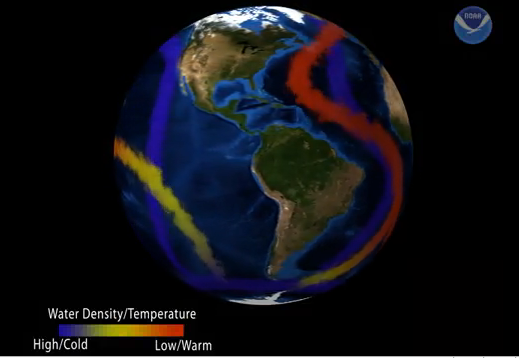Global ocean currents and thermohaline circulation
Reading assignment
Read the link below.
- Broecker, GSA today What If the Conveyor Were to Shut Down? Reflections on a Possible Outcome of the Great Global Experiment
Recall from Lesson 3 that water density increases with increasing salinity and decreasing temperature. Water density varies throughout the ocean and the water at the bottom of the ocean is densest, of course. Ocean-atmosphere interactions have important implications for global ocean currents. For example, think about what would happen if a large scale surface current continually lost heat. The colder it got the denser the water would be, and eventually that water would become dense enough to sink, and become deep water. Now lets add in evaporation. Imagine that water was continually evaporated from our surface current. This would make it saltier, which would increase the density. Eventually, the density would increase enough for the water to sink and become deep water.

This is exactly what happens in the North Atlantic. But, if deep water forms in one place, then surface water has to form somewhere else; we can't push water into the deep ocean without something coming back to the surface, and in fact, surface water forms in various places in the ocean.
Look at the image above, and then back at the figure at the top of page 1 of this lesson. On page 1, the arrows are red for surface currents and blue for deep currents. The colors are a bit hard for me to see, but note that in the North Atlantic, a surface current flows north and a deep current flows south. This means that deep water forms in the North Atlantic.
It's important to appreciate that any Figure drawn at this scale, the entire ocean, is approximate. Don't take everything you see in these figures as the gospel. For a different perspective, have a look at this animation.
The figure below shows the general structure of water masses as a function of depth in the ocean.

Activity 2
Why does surface water sink in the North Atlantic? Let's calculate the density differences between surface waters in the tropics vs. where deep water forms in the north.
Go to the Windows to the Universe is web site and read the information there (under: Density of Ocean Water)
Then click on the links in the second paragraph for ("the temperature of the water and the salinity of the water....")
Use those images to determine Temperature and Salinity in the North Atlantic off the coast of Florida and off the coast of Ireland.
For temperature, you'll need to click on the link for "Sea Surface Temperature Image," which is under the heading "Related Links." If you have trouble finding it, click here
For salinity, you can just click on "the salinity of the water" and then on the map at the top of the page.
The colors are a bit tricky to distinguish, but do your best and report the values you chose.
- Calculate the density of the water masses off the coast of Florida and off the coast of Ireland. Make sure to record your values for temperature and salinity. You can use the Ocean Water Density Calculator for the density calculation
- Comment. Is this about what you expected? How are water densities normally determined in the ocean?
Submitting your work
Please put your answers in a file and drop that in the dropbox for Lesson 4, Activity 2 on Canvas.
Save your document as either a Microsoft Word or PDF file in the following format:
L4_Activity2_AccessAccountID_LastName.doc (or .pages or .pdf)
For example, student Elvis Aaron Presley's file would be named "L4_Activity2_eap1_presley.doc".
Grading criteria
See the grading rubric for specifics on how this assignment will be graded.